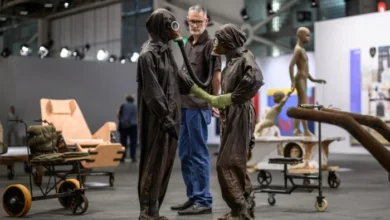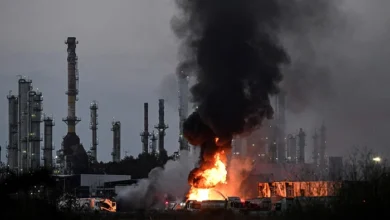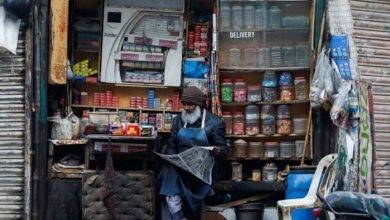Sindh’s old experts have been discussing the disagreement between the irrigation department and Wapda over a Rs125 billion Sindh barrage, approved by Prime Minister Imran Khan in 2019.
Sindh has three barrages on the mighty River Indus: at Sukkur, Kotri and Guddu, which was built last. These big structures control and channel the river’s flow of water so that the province’s vast canals connected to farmland can be watered to grow crops.
When Kotri Barrage was completed in 1955, irrigation engineers knew that its dykes or bunds would cut off a major portion of the Indus Delta. The river’s flow would be confined between Keti Bunder and Shah Bunder. Before Kotri, the Indus used to flow freely down from Hyderabad city through several bye-rivers, inundating vast portions of land. This mechanism used to benefit the deltaic plains by flushing out the salt that built up in them after dry periods.
The designers of the barrage also knew that after they built systems that gave farmers continuous irrigation, the farming would become more intense. Farmers would change their crop patterns. One effect would be to restrict puncho irrigation flows in abandoned deltaic plains (the rice crop free-flow watering method). That is why the engineers who prepared the final report on Kotri proposed a deltaic bund to keep expected sea intrusion at bay in the future. History tells us, however, that almost all of our problems are caused by half-cooked and inconsistent development priorities.
Since Kotri barrage, we have been running the system like business-as-usual. Incredibly, no one realized that even if we sent 100MAF of water downstream from Kotri, the Indus Delta would remain the same. The river flows between Keti Bunder and Shah Bunder as it is hemmed in by embankments on both sides. Even after Kotri was constructed its canals used to be major contributors to the Indus Delta. We had a complete a surface drainage system built in the seventies.

Historically, farmers sowed rice in the summer. Rice is a three-month crop. Its irrigation system is called puncho because the rice paddy needs to be irrigated and drained continuously. That drained off water is used to refresh deltaic plains. This is why it is referred to as a wet crop. But what happened with time is that we switched to dry crops like sugar cane. This is a dry crop, meaning it produces no drainage surplus for the delta.
The first shock to the Indus delta was the construction of Kotri Barrage. Its dykes isolated the river from major portions of the deltaic plains. Before the barrage was built, the river used to flow freely. The second shock to the delta came with changing cropping patterns. The wet crop rice was pushed aside and we started growing dry crops like sugar cane, cotton, vegetables etc.
So, we did not built dykes to protect the delta as proposed in 1955. We did not control cropping intensities and changing crop patterns. We did not make it easier for the river to flow freely in the delta. The only thing we did do is keep up the activism for it was useful for the masses to learn about our mistakes.
How does the Netherlands manage its delta when its natural surface is lower than sea level? They take care of inland water consumption and keep their deltaic areas enriched and guarded with artificial lakes, barrages and lock gates. It treats wastewater to keep up a water supply to the delta. Idea is simple; it was worked out by Ghyben Herzberg long ago. His theory says that sea intrusion starts from ground water or is directly proportional to GW depletion. Simply put, if we do not spread out river water to recharge ground water in the delta and rationalize upstream abstractions, then please do not be afraid of sea intrusion.

The basic idea of the Sindh Barrage is actually Sindh’s dream of tackling the sea intrusion. There is a long list of technical experts who advocated this option and dykes since the early 1950s and 1960s. The phrase “downsteam Kotri escapages” surfaces repeatedly in publications, seminars and conferences, but we do not know how the flows of the river will save the delta when the river itself is isolated. We can keep sending water downstream and it will keep on escaping. In fact, we need to become acquainted with the term “downstream water ponding”. That is how other countries have fought sea intrusion. Satellite imagery from 1984 to 2020 clearly shows how the number of water bodies and natural lakes in the deltaic region have dropped and been turned into agricultural lands.

Wapda experts say that the barrage and canals are supposed to operate during floods and spread river water and silt into the abandoned creeks of the Indus Delta. This will not only wash out the salinity but also rejuvenate the ecology of the delta. The flood flows open up opportunities for bio saline agriculture and fisheries.
There was an impression that a barrage will create waterlogging and salinity, but a study of the Netherlands delta management system and Vietnam Bio Saline Fisheries tell us that these mechanisms not only keep sea intrusion in check but also open up shrimp and fish farming. Wapda is planning seepage interceptor drains to protect cultivated areas in the Kotri Barrage command. The area is covered by Kotri Barrage surface drains, which may need rehabilitation or maintenance.
The Indus Delta, specifically where this barrage and canals are proposed, is in quite a miserable state. There is a limited and rugged road network, the other public infrastructure is always in shambles due to salinity and poverty indicators are high. Deltaic or sea fisheries are under control of local lords. Life is difficult for the poor here. Just imagine, since 2001 we have not been able to install a water supply scheme for Keti Bunder from a nearby irrigation canal, which was approved by the provincial government of the time.

Local experts are of the opinion that Barrage construction activity will create jobs. They want training and capacity building for locals who can do the biosaline agriculture and fisheries work.
The Barrage project should support mangrove plantation replicating what the Sindh Forest Department and IUCN did on the right bank of the Indus. The increased availability of river water and its spread in deltaic plains can work wonders. The deltaic forestry options should be implemented through the Government of Sindh.
Such a project will only be successful if the custodians own it. In this case it is the Sindh government. There should be consultations with the Government of Sindh and irrigation department engineers should be part of the barrage design and construction. This was how it was done when Guddu Barrage was built in 1962. Wapda and the Irrigation department jointly planned, designed and completed the assignment. Otherwise, this entire exercise will be futile.






